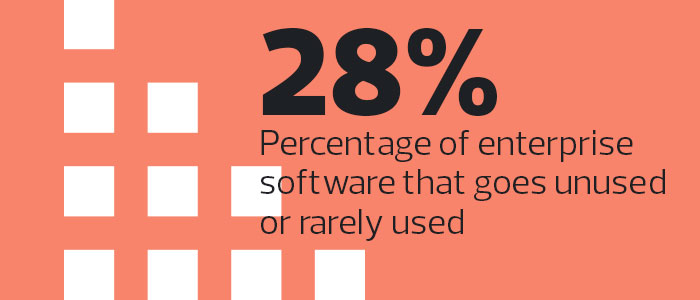4 Tips for Monitoring and Reducing Software Licensing Waste
With public-sector budgets being notoriously tight, it is more important than ever for IT departments to make every dollar count. An effective method for organizations to stretch their IT budget is to look for ways to eliminate waste. Tracking down unused software licenses is a great place to start.
How much money can better software license management really save? According to a January 2015 report from 1E, wasted software licenses cost an average of $259 per desktop, a figure that quickly adds up when one considers the number of desktops in an organization.
The report’s figures were based on a four-year study that found global average waste of about 37 percent per company. In some organizations, the percentage of waste is much higher. According to the study, in the United States alone, organizations collectively wasted $30 billion dollars on unused software.
Given the staggering sums of money that organizations may be wasting on unused licenses, it is easy to see how software license optimization could potentially save public-sector organizations a considerable amount of money. The key is tracking actual waste in the workplace.
1. Use Tracking Tools to Your Advantage
One obvious option for tracking down unused software is to employ tools that determine when each application was last used. The best method varies by operating system.
For example, older versions of Microsoft Windows (prior to Windows 7) natively display the date when each installed application was last used. Newer versions (from Windows 7 to the current version) don’t provide this information, even when a “Last Used” column is installed through the Control Panel.
Fortunately, there are a number of tools that can help organizations that use newer versions of Windows to determine which applications are being used and which are not.
LANDESK IT Asset Management Suite includes a mechanism that monitors license usage across the enterprise. This monitoring process is designed to ensure software licensing compliance. However, it also has the ability to reclaim unused licenses and decommission unused applications, if necessary. This process can even be targeted to specific users or groups.
Another example is Symantec Asset Management Suite. Like LANDESK’s asset management product, this software provides information on license compliance, but it also provides information on license underutilization.
Given the potential savings, establishing a software license utilization policy could be well worth the investment, and the tools exist to help IT departments monitor software use easily.

SOURCE: Aberdeen Group, "Reclaiming IT Budgets Through Software License Optimization," March 2016
2. Consider the Indirect Cost of Wasted Licenses
Regardless of whether software has a perpetual license, there are indirect costs associated with allowing unused software to remain installed on company desktops. These costs come in the form of wasted hardware resources or administrative costs related to software maintenance. Removing unused software from desktops may even reduce costs through the improved security that comes from reducing the computer’s potential attack surface.
3. Make Audits Work for You
Much of the software license waste that exists can probably be attributed to an organization’s efforts to comply with software licensing requirements.
According to the Aberdeen Group, the average organization receives four software audits each year, and about 10 percent of organizations are audited between 11 and 15 times per year.
The frequency of such audits and the penalties for noncompliance have driven most IT shops to perform their own internal license audits. These internal audits are most commonly used as a tool for ensuring license compliance but could also be used as a tool for decreasing licensing costs.
Although perpetual software licenses were once common, such licenses have largely been replaced by subscription-based licenses that must be periodically renewed. While it is imperative for an organization to properly license its software, internal software audits are likely to reveal that an organization is paying for a greater number of licenses than it really needs. The organization may be able to reduce its license count when it is time for renewal, reducing costs without compromising license compliance.
4. Reinvest Savings from Combating Licensing Waste
Software license waste comes in a variety of forms. Waste can be attributed to applications that are purchased, installed and never used. Similarly, purchasing a greater number of software licenses than what is legally required may also account for waste.
In either case, waste can have a dramatic impact on a public-sector organization’s already-thin budget. By eliminating software license waste, an organization may be able to reinvest cost savings into more critical IT projects.








